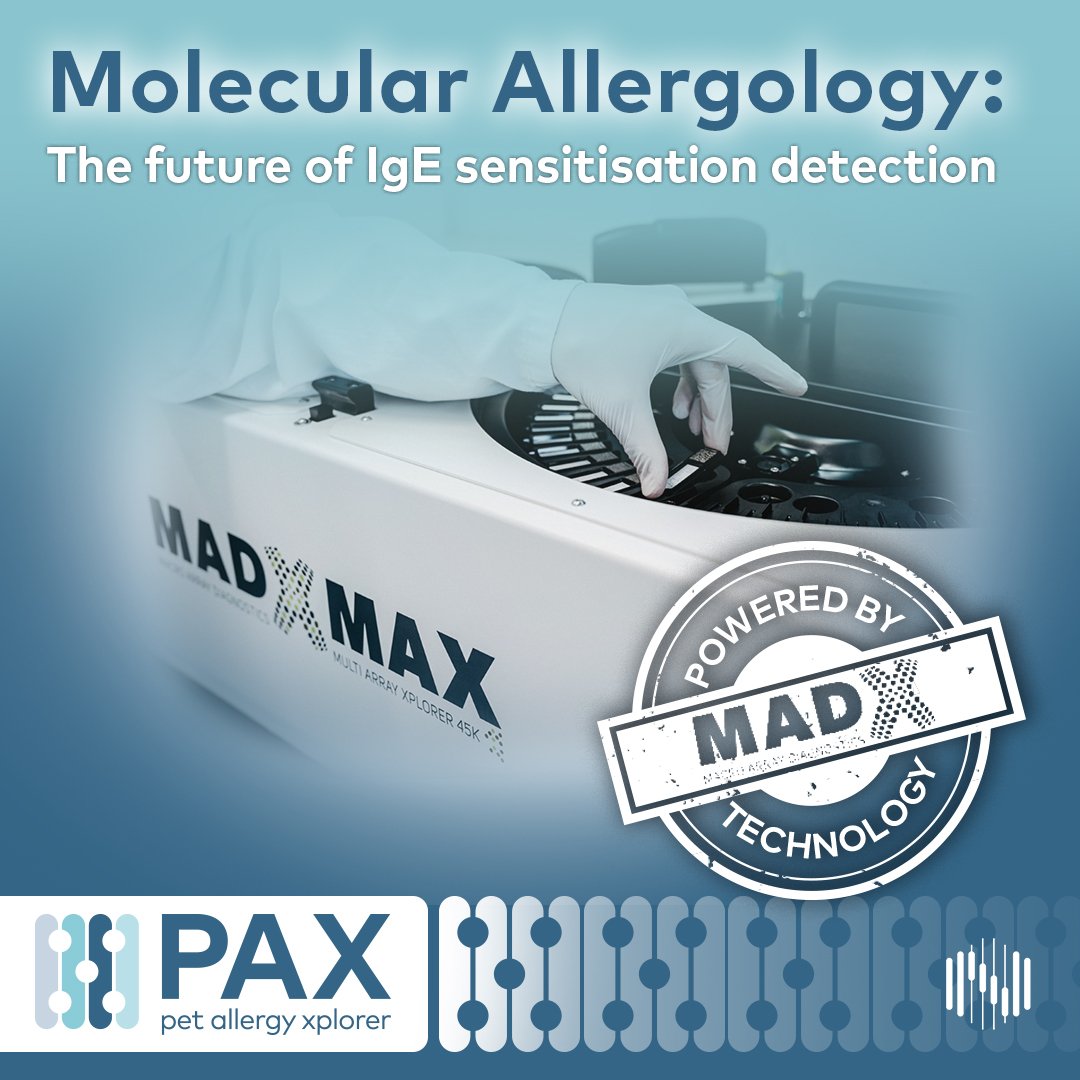Molecular allergology is a state-of-the-art approach to the detection of sensitisations, whereby defined single allergen components are used for the determination of specific IgE in place of traditionally-used allergen extracts. The molecular components are purified or recombinant proteins that provide a higher level of standardisation than allergen extracts and enable a more precise identification of IgE sensitisations. Pet Allergy Xplorer (PAX) is the first commercial serological IgE-specific test that uses allergen extracts and molecular components to identify which allergens are affecting pets.
THE PROBLEM
Traditionally, allergy testing in veterinary medicine involves placing an allergen extract on an enzyme linked immunoassay (ELISA) plate to incubate the serum and then administering a reagent that recognizes immunoglobin E (IgE). The resultant color reaction indicates how much IgE is present. This technique, which is used by veterinary laboratories world-wide, has not changed for decades. However, results can vary considerably, depending on the extract used, and false negatives can occur if clinically relevant protein allergen concentrations are not sufficient. For example, the extract for the house dust mite, a common pet allergen, is made by grinding the mite, adding solvents to release the allergenic proteins, and purifying the proteins.
The house dust mite contains more than 10,000 proteins, but only about 40 that cause an allergic reaction are recognized. This means a low percentage of the allergy-causing proteins are seen when an extract is evaluated, especially if a pet has a low IgE level against a particular allergen. This can easily result in a false negative. In addition, extracts can vary not just between laboratories but also allergenic extract, making results hard to reproduce.
THE SOLUTION
To gain more accurate and sensitive information, tests are needed to identify each individual allergenic protein. Instead of testing for the house dust mite (or any particular allergen) as a whole, techniques are needed to test for the specific proteins that cause an allergic reaction. Human practitioners use molecular allergology to determine the allergens causing problems to provide their patients with a better level of care.
Macro Array Diagnostics launched the Allergy Explorer (ALEX), which provides a sensitization profile for human patients based on a test panel composed of allergen extracts and molecular allergens. Since their founding in 2016, the company has launched two generations of ALEX, offering a panel that covers nearly 100% of the world’s relevant allergens. It also developed the Food Xplorer (FOX), to detect IgG-mediated food intolerances.
THE INNOVATION
After experiencing allergies myself, and being tested using molecular allergology, I thought the technology could be extremely beneficial to veterinary medicine.
This led to Nextmune partnering with Macro Array Diagnostics to develop the Pet Allergy Xplorer (PAX), the first commercial serological IgE-specific test that uses allergen extracts and molecular components to identify which allergens are affecting pets.
Advantages include:
- Improved reproducibility — A state-of-the-art robot builds each ELISA testing array, providing a the ability to produce an effective hyposensitization therapy that will provide more relief for the pet.
- Improved cross-reactivity identification — Using allergen extracts and molecular components in one test will help identify allergenic cross-reactivity.
- Elucidated poly sensitization — When multiple allergens cause a reaction, PAX will help identify the primary offenders.
- Individualized results — The results provided to the veterinarian will be specific to the region where they live, as well as the pet’s species.
- Improved accuracy — PAX uses uniform production method that exceeds current ELISA plate building reproducibility. In addition, a standardization process is used to make the allergenic extracts, improving reproducibility.
- Increased data — Typical allergy testing via serum provides about 90 results, and intradermal testing provides around 60 to 80 results. The PAX cartridge holds 300 positions—100 of which will be extracts and 200 will be molecular components.
- Automated technology — Robots are used throughout the process, decreasing human error. The microarray dots during the plate manufacturing process are dispensed by a robot. In addition, a robot pipettes the serum during the testing phase. Controls are built into the PAX cartridge to ensure the sample has sufficient IgE for testing, and these controls also indicate if the cartridge is used properly.
- Improved treatment — The more accurate and sensitive results that PAX provides will improve pertinent allergens are identified to prevent confusion.
- Ongoing development — The cartridges currently contain the allergenic components and extracts that prevailing research indicates are clinically relevant. As data is gathered through testing, other allergenic components may be discovered. For example, if an extract continues to indicate positive while the individual molecular components indicate negative, we need to determine if another unidentified component is present or a cross reactivity is occurring. This data will help us characterize molecules to add in a single well-characterized anti-IgE monoclonal antibody to detect pet IgE, ensuring a detection level. PAX also uses technology to block cross-reactive carbohydrate determinants (CCD). In some cases, CCDs bind to IgE receptors, creating false positives. The PAX technology uses a blocking agent to prevent this binding. Allergy tests that do not use CCD blockers identify numerous allergens, many of which are irrelevant. This technology ensures only the future versions, revolutionizing the research in pet allergies.
Nextmune is the only veterinary diagnostic laboratory currently using molecular allergology. This next generation test will allow veterinarians to more accurately and sensitively diagnose allergic pets to facilitate treatment strategies. The initial launch for dogs is scheduled for January 2023, followed by tests for cats and horses.
Thierry Olivry, DrVet, PhD, DipECVD, DipACVD, Scientific Advisor and Project Leader
Dr. Olivry is a graduate of the University of Toulouse, France. He completed a dermatology residency and PhD in comparative pathology at UC Davis and is a Diplomate of both ACVD and ECVD. Dr. Olivry spent most of his career as a clinician-scientist at NC State University researching allergic and autoimmune skin diseases and now lives in Riga, Latvia.
 Global English
Global English

 Danmark
Danmark
 Deutschland
Deutschland
 UK
UK
 España
España
 France
France
 Bélgique (FR)
Bélgique (FR)
 Nederland
Nederland
 Norge
Norge
 Sverige
Sverige
-Dec-21-2023-09-46-12-9148-AM.jpeg)



